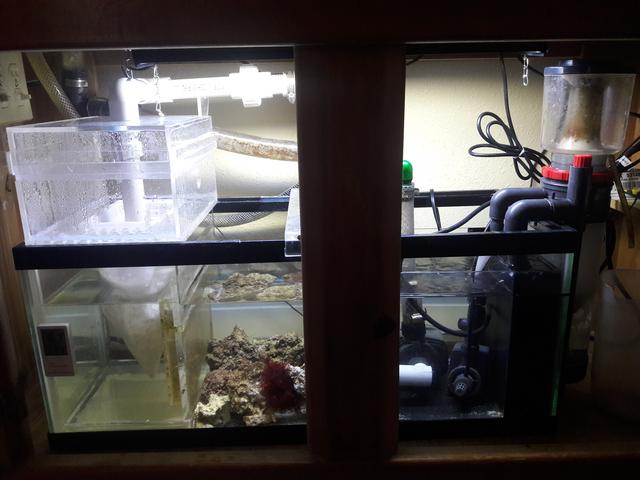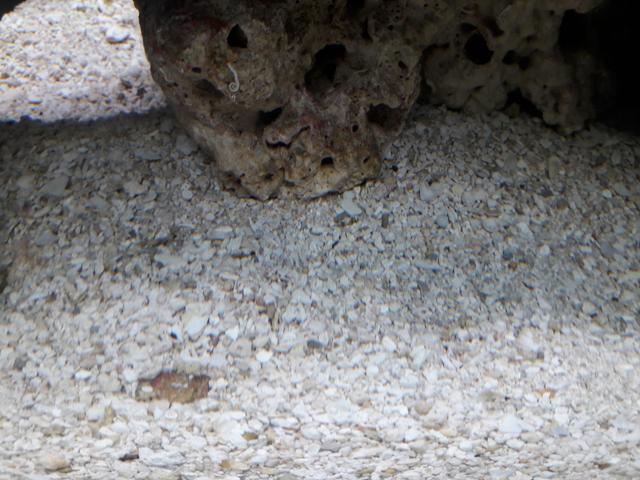


|
 |
|
|
#1 |
|
Registered Member
Join Date: May 2018
Location: Lafayette, Colorado
Posts: 2
|
Newb looking for some guidance
Hello everyone, my name is Chris and I am new to the reef game.
I recently picked up a complete stocked fowlr set up from a guy on craigslist that was leaving town, with the only catch being I had to have it moved within 12 hours. This of course didn't give me any time to do my research and resulted in me winging it. Luckily I have been researching reef tanks on and off for years in hopes to one day be able to pull the trigger, so I wasn't completely lost. I was able to get the tank moved, refilled (with 100% of the water that was in it as I had no way to make new water and the LFS was closed that day), and restocked without losing anything. The next day I tested the water. Ph - 8.2 Ammonia - 0 Nitrites - 0 Nitrates - 160 + I freaked to say the least. I performed a 50% water change vaccuming the bed thoroughly which produced a nasty chocolate milk looking crap. I have continued to test daily and do 50% water changes. I have done a total of 6 water changes. The first 3 resulted in nitrates still testing at 160+. The 4th brought me down to around 80. The 5th down to 40. And after the last water change yesterday I am still at 40. Ammonia and nitrite have remained at 0 and have never spiked due to the move or anything else I have done. In theory I should be removing 50% of the nitrates with the water changes, but not the case this last time around. I have been buying all this water from the LFS for 1.00 per gallon which is getting expensive. Of course I didnt test the nitrates in the source water this last time as it had been good all the previous times. I am thinking this is what is going on. How long should it take me to get the levels down to acceptable range? I started dosing vodka last night at 0.3ml per day. (Hope that skimmer is working properly.) The tank is a 75 gallon with a 20 long diy sump. Filter sock on the overflow end, fuge with live rock ( i removed the disgusting detritus ridden sand bed that I believed to be causing the nitrate issue) and a skimmer and my return pump in the other end. Skimmer has no name on it or model or anything and Im not sure it is even working properly as the skimmate I am getting is minimal and basically a clear / light green hue foam. It is stocked with a pair of clowns, 1 banghai cardinal, one yellow tang, one tiny yellow tail damsel, 2 of what i believe to be sargent majors, 1 trochus snail, 1 astrea snail, and one nassarius snail. I will include some photos and hopefully someone can get me on the right track. I am sure it is just a patience game at this point, but I want to make sure I am not missing anything. Thanks in advance for any help!    
|
|
|

|
|
|
#2 |
|
RC Mod
 Join Date: Mar 2002
Location: Mountain View, CA, USA
Posts: 88,616
|
 To Reef Central The fish will be fine with nitrate at 150 ppm and likely much higher. I wouldn't worry too much about that. Over the long haul, if you want to keep the nitrate level down or add certain kinds of corals, that coarse substrate might become an issue. They tend to accumulate debris, which decays and releases nitrate into the water. I ditched all my crushed coral for that reason. For the time being, though, you could just enjoy the tank. 
__________________
Jonathan Bertoni |
|
|

|
|
|
#3 |
|
Registered Member
Join Date: Sep 2003
Location: North Carolina
Posts: 20,050
|
Yeah.. you are fine keep working on it and the levels will drop..
__________________
Who me? |
|
|

|
|
|
#4 |
|
Registered Member
Join Date: Feb 2014
Posts: 1,765
|
It’s probably not the source water. You caused a lot of stuff to get stirred up with the move and the biological filter is doing it’s job. Ammonia is getting produced and going through the nitrogen cycle quickly and producing enough nitrates to register. Also how sure are you that the test is accurate? Either way you are doing everything you can. The skimmer appears to be a coralife super skimmer. Not the best. Is it in a chamber that the water level stays constant or is it in the same chamber as the return pump? This will affect is efficacy. I personally would replace the skimmer as soon as you can save up t do it, but definitely leave it running until you have a replacement. It may also take a few days to break in again if you cleaned it with anything.
__________________
“In wine there is wisdom; in beer there is freedom, in water there is bacteria.” - Benjamin Franklin Current Tank Info: 90 gallon reef. Biocube 29 lionfish tank. Mantis tank. |
|
|

|
|
|
#5 |
|
Registered Member
Join Date: Sep 2003
Location: North Carolina
Posts: 20,050
|
The fact that through water changes they have reduced nitrates from 160+ to 40 shows that it is in the water..
Its fairly well known/proven that for the most part a 50% water change will reduce nitrates by 50%.. Now there are always sources of nitrates in a tank that are not the water themselves.. The water is not producing nitrates.. Its just where its ending up.. So water changes are a big part of reducing nitrates in the system.. Then identify/reduce the source to keep them from gaining ground again..
__________________
Who me? |
|
|

|
|
|
#6 | |
|
Registered Member
Join Date: Feb 2014
Posts: 1,765
|
Quote:
__________________
“In wine there is wisdom; in beer there is freedom, in water there is bacteria.” - Benjamin Franklin Current Tank Info: 90 gallon reef. Biocube 29 lionfish tank. Mantis tank. |
|
|
|

|
|
|
#7 |
|
Registered Member
Join Date: Feb 2014
Posts: 1,765
|
It could also be a testing error. Either in procedure or reading the color in a different light, being slightly colorblind and not knowing it or even an expired or faulty test kit.
__________________
“In wine there is wisdom; in beer there is freedom, in water there is bacteria.” - Benjamin Franklin Current Tank Info: 90 gallon reef. Biocube 29 lionfish tank. Mantis tank. |
|
|

|
|
|
#8 |
|
Registered Member
Join Date: May 2018
Location: Lafayette, Colorado
Posts: 2
|
I was able to test a bit of the left over source water from the LFS, and it was 0 across the board.
I went ahead and did another 20 gallon water change last night. Nitrates are now at 20. I am assuming all should be well soon so that i can start adding some corals. I have gotten alot of advice that the crushed coral bed could be a problem. Which leads to my next question, is it possible to replace this bed without causing a cycle or any other detrimental impact as a result of replacing it? Thanks to everyone who has taken the time to respond. Much appreciated. |
|
|

|
 |
|
|